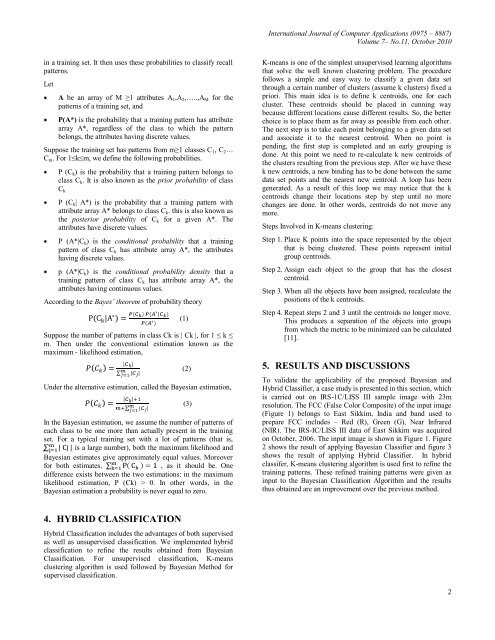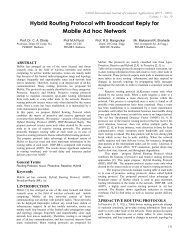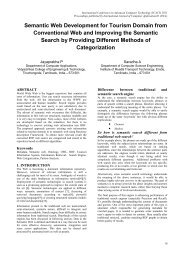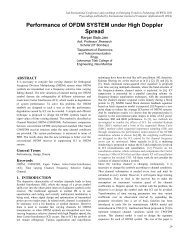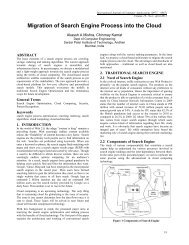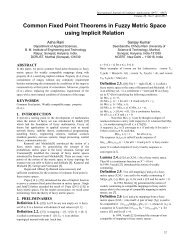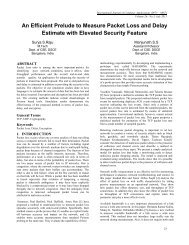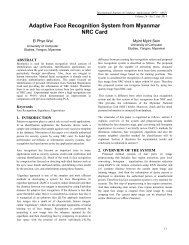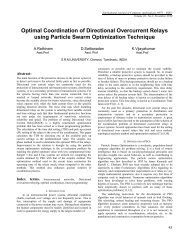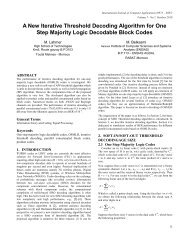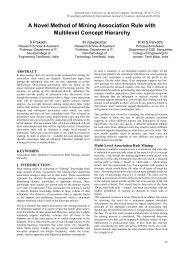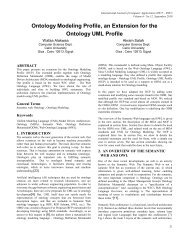Land Cover Classification of Remotely Sensed Satellite Data using ...
Land Cover Classification of Remotely Sensed Satellite Data using ...
Land Cover Classification of Remotely Sensed Satellite Data using ...
You also want an ePaper? Increase the reach of your titles
YUMPU automatically turns print PDFs into web optimized ePapers that Google loves.
International Journal <strong>of</strong> Computer Applications (0975 – 8887)<br />
Volume 7– No.11, October 2010<br />
in a training set. It then uses these probabilities to classify recall<br />
patterns.<br />
Let<br />
A be an array <strong>of</strong> M ≥1 attributes A 1 ,A 2 ,…..,A M for the<br />
patterns <strong>of</strong> a training set, and<br />
P(A*) is the probability that a training pattern has attribute<br />
array A*, regardless <strong>of</strong> the class to which the pattern<br />
belongs, the attributes having discrete values.<br />
Suppose the training set has patterns from m≥1 classes C 1 , C 2 …<br />
C m . For 1≤k≤m, we define the following probabilities.<br />
P (C k ) is the probability that a training pattern belongs to<br />
class C k . It is also known as the prior probability <strong>of</strong> class<br />
C k.<br />
P (C k | A*) is the probability that a training pattern with<br />
attribute array A* belongs to class C k . this is also known as<br />
the posterior probability <strong>of</strong> C k for a given A*. The<br />
attributes have discrete values.<br />
P (A*|C k ) is the conditional probability that a training<br />
pattern <strong>of</strong> class C k has attribute array A*, the attributes<br />
having discrete values.<br />
p (A*|C k ) is the conditional probability density that a<br />
training pattern <strong>of</strong> class C k has attribute array A*, the<br />
attributes having continuous values.<br />
According to the Bayes’ theorem <strong>of</strong> probability theory<br />
Suppose the number <strong>of</strong> patterns in class Ck is | Ck |, for 1 ≤ k ≤<br />
m. Then under the conventional estimation known as the<br />
maximum - likelihood estimation,<br />
Under the alternative estimation, called the Bayesian estimation,<br />
In the Bayesian estimation, we assume the number <strong>of</strong> patterns <strong>of</strong><br />
each class to be one more than actually present in the training<br />
set. For a typical training set with a lot <strong>of</strong> patterns (that is,<br />
is a large number), both the maximum likelihood and<br />
Bayesian estimates give approximately equal values. Moreover<br />
for both estimates,<br />
, as it should be. One<br />
difference exists between the two estimations: in the maximum<br />
likelihood estimation, P (Ck) > 0. In other words, in the<br />
Bayesian estimation a probability is never equal to zero.<br />
(1)<br />
(2)<br />
(3)<br />
K-means is one <strong>of</strong> the simplest unsupervised learning algorithms<br />
that solve the well known clustering problem. The procedure<br />
follows a simple and easy way to classify a given data set<br />
through a certain number <strong>of</strong> clusters (assume k clusters) fixed a<br />
priori. This main idea is to define k centroids, one for each<br />
cluster. These centroids should be placed in cunning way<br />
because different locations cause different results. So, the better<br />
choice is to place them as far away as possible from each other.<br />
The next step is to take each point belonging to a given data set<br />
and associate it to the nearest centroid. When no point is<br />
pending, the first step is completed and an early grouping is<br />
done. At this point we need to re-calculate k new centroids <strong>of</strong><br />
the clusters resulting from the previous step. After we have these<br />
k new centroids, a new binding has to be done between the same<br />
data set points and the nearest new centroid. A loop has been<br />
generated. As a result <strong>of</strong> this loop we may notice that the k<br />
centroids change their locations step by step until no more<br />
changes are done. In other words, centroids do not move any<br />
more.<br />
Steps Involved in K-means clustering:<br />
Step 1. Place K points into the space represented by the object<br />
that is being clustered. These points represent initial<br />
group centroids.<br />
Step 2. Assign each object to the group that has the closest<br />
centroid.<br />
Step 3. When all the objects have been assigned, recalculate the<br />
positions <strong>of</strong> the k centroids.<br />
Step 4. Repeat steps 2 and 3 until the centroids no longer move.<br />
This produces a separation <strong>of</strong> the objects into groups<br />
from which the metric to be minimized can be calculated<br />
[11].<br />
5. RESULTS AND DISCUSSIONS<br />
To validate the applicability <strong>of</strong> the proposed Bayesian and<br />
Hybrid Classifier, a case study is presented in this section, which<br />
is carried out on IRS-1C/LISS III sample image with 23m<br />
resolution. The FCC (False Color Composite) <strong>of</strong> the input image<br />
(Figure 1) belongs to East Sikkim, India and band used to<br />
prepare FCC includes – Red (R), Green (G), Near Infrared<br />
(NIR). The IRS-IC/LISS III data <strong>of</strong> East Sikkim was acquired<br />
on October, 2006. The input image is shown in Figure 1. Figure<br />
2 shows the result <strong>of</strong> applying Bayesian Classifier and figure 3<br />
shows the result <strong>of</strong> applying Hybrid Classifier. In hybrid<br />
classifer, K-means clustering algorithm is used first to refine the<br />
training patterns. These refined training patterns were given as<br />
input to the Bayesian <strong>Classification</strong> Algorithm and the results<br />
thus obtained are an improvement over the previous method.<br />
4. HYBRID CLASSIFICATION<br />
Hybrid <strong>Classification</strong> includes the advantages <strong>of</strong> both supervised<br />
as well as unsupervised classification. We implemented hybrid<br />
classification to refine the results obtained from Bayesian<br />
<strong>Classification</strong>. For unsupervised classification, K-means<br />
clustering algorithm is used followed by Bayesian Method for<br />
supervised classification.<br />
2


